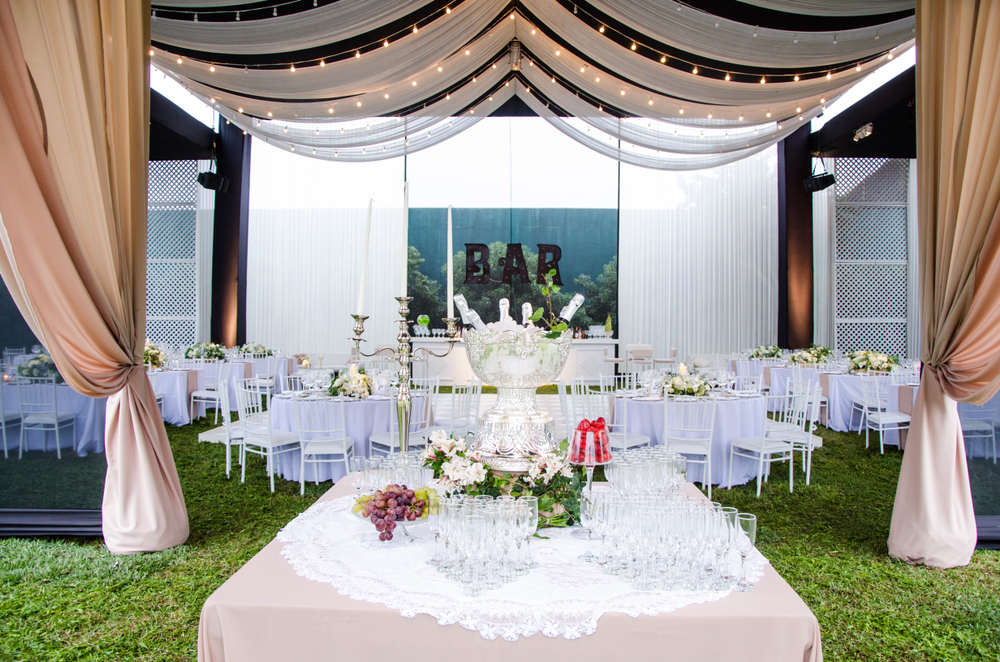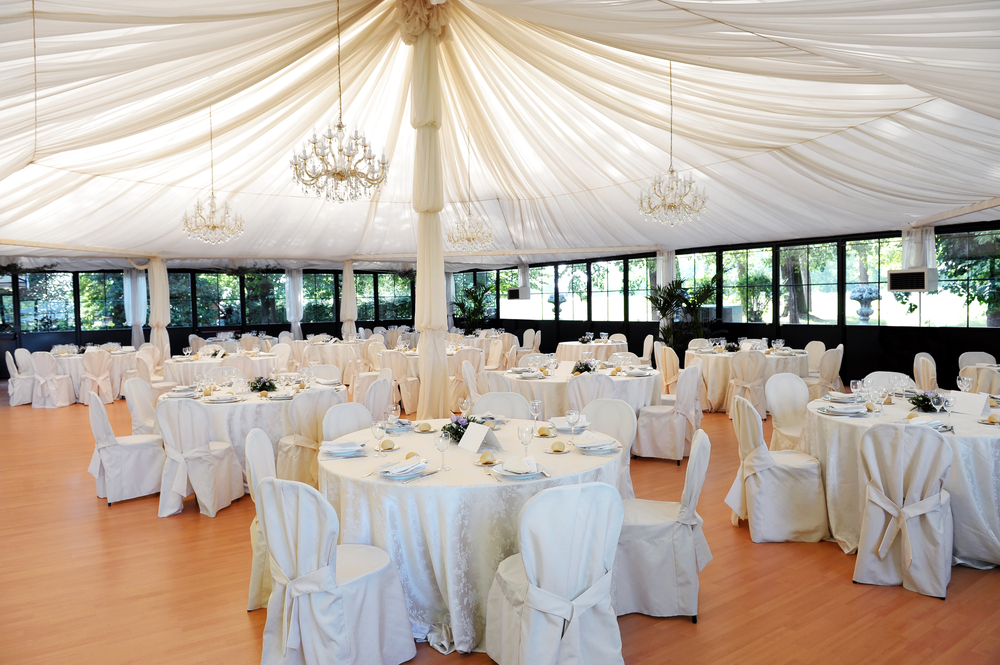When planning an event, drape can add a touch of elegance and sophistication to the space. They can transform a room and create a dramatic backdrop for photos. However, before ordering or renting drape, it is crucial to take accurate measurements to ensure they fit the space and that the type of drape you select complements your theme.
This article will guide you through the definition, types, and styles of drape, choosing the right ones for your event, drape hanging methods, hardware, and measurement tips.
Jump Links
- Definition of Drape
- Types And Styles Of drape
- Choosing The Right drape For Your Event
- Drape Hanging Methods
- Hardware For Hanging Drape
- Drape Measurement Tips
- Final Thoughts
Definition of Drape
Drape refer to long, hanging fabrics that fully or partially cover windows, doorways, or walls for decorative or functional purposes. drape are often made of heavier, more formal fabrics than curtains and can be lined to help control light and temperature. They are typically hung from a rod or a rail above the window or door and can be opened or closed using various mechanisms.
Drape come in various styles, colors, and patterns and can be an essential part of the decor in a room, adding texture, vibrance, and elegance.
Types And Styles Of Drape
You can use various types and styles of drape for events, depending on the desired ambiance and the purpose of the occasion. The following are some popular options:
- Pipe and Drape – This versatile type of drape consists of adjustable upright poles and horizontal crossbars that create partitions or backdrops. The fabric used for this type of drape is typically heavyweight cotton or synthetic material.
- Sheer drape – These are lightweight and transparent drape you can use to create a romantic and dreamy ambiance. They are great for weddings, baby showers, and other events where a soft and elegant look is desired.
- Velvet drape – This type of drape is typically made of a heavyweight cotton or synthetic velvet material and creates a luxurious and opulent ambiance. Velvet drape are fantastic for formal events, like galas and award ceremonies.
- Gossamer drape – These are lightweight, transparent drape often used to create a whimsical and ethereal ambiance. They are perfect for outdoor events, like garden parties or beach weddings.
- Satin drape – Satin drape are made of a lightweight, shiny fabric and are often used to create a glamorous and sophisticated ambiance. They are classic for proms, gala dinners, and black-tie events.
- Backlit drape – These drape are often made of sheer material and are lit from behind to create a dramatic and stunning effect. They are perfect for fashion shows, product launches, and corporate events.
- Printed drape – You can use printed drape to add a customized touch to an event. They can be printed with logos, graphics, or patterns to create a unique backdrop or accent piece.
- Swag drape – You can hang swag drape to create a flowing, curved effect. You can also use them to create an elegant and classic look for events such as weddings and galas.
Ultimately, the type and style of drape you choose will depend on your taste, preferences and the occasion.
Choosing The Right drape For Your Event
When measuring drape for an event, there are several factors you should consider to ensure that the drape fit properly and look great. Below are some things to keep in mind:
- The budget – Firstly, consider your budget when choosing the size and style of drape. More elaborate drape from higher-quality fabrics will be more expensive than simpler styles from less expensive materials.
- The event type – The event you host will also determine the drape size. For example, if you are hosting a wedding reception, you should opt for longer, flowing drape that create a romantic atmosphere. On the other hand, if you are hosting a corporate event, consider more formal and streamlined drape.
- The height of the ceiling – The height will determine the length of the drape. Measure from the top of the ceiling down to where you want the drape to end.
- The width of the area – Measure the width of the part where you intend to hang the drape. This will help you determine how many drape panels you need and how wide each panel should be.
- The type of fabric – Different fabrics have different weights and draping properties. Some may need to be cut wider or longer to achieve the desired look. Consider the weight and thickness of the fabric when measuring.
- The style of the drape – Different drape may require different measurements. For example, if you want a gathered look, you may need to order more fabric to achieve the desired effect.
- The hardware and hanging method – Consider the type of hardware you will use to hang the drape, such as a pipe and drape system or a suspension system. The hardware you use will affect the height and width of the drape you need.
- The placement of any lighting or decorations – If you plan to hang lighting or decorations from the drape, ensure you account for this when measuring. You may need to order extra fabric to accommodate the weight of these items.

- Consult with a professional – If you need help choosing the size and style of drape to select, consider consulting with a professional event planner or decorator. At Quest Events, we ensure that the drape fit properly, look great, and create the desired atmosphere for the occasion.
Overall, it’s vital to consider the factors above and take accurate measurements when ordering drape for an event. Additionally, if need be, seek professional help before executing your vision.
Drape Hanging Methods
There are several methods for hanging drape for an event, depending on the type of drape and the venue. Below are some examples:
- Pipe and Drape System – This is a popular and versatile method for hanging drape at events. The system consists of adjustable uprights, crossbars, and base plates that can be configured to create a freestanding frame for hanging drape. The drape are then hung from the crossbars using drapery hooks.
- Grommets and Hooks – This method involves hanging drape using grommets and hooks. The grommets are placed at the top of the drape, and the hooks are inserted through the grommets and attached to a support system, such as a pipe and drape system or a rigging system.
- Velcro Strips – These can hang drape on walls or other surfaces. One side of the Velcro is attached to the back of the drape, and the other side is attached to the wall or surface.
- Rigging System – You will require a rigging system for larger drape or more complex installations. This involves using cables, wires, or ropes to suspend the drape from the ceiling or other high points in the venue.
- Tension Rods – For smaller or lighter-weight fabrics, you can use tension rods to hang the drape. For this method, the rods are placed in the window or doorway, and the drape are hung from the rod using drapery clips or rings.
It is critical to consult with a professional or experienced event planner to determine the best method for hanging drape for your specific event and venue. At Quest Events, we partner with clients to provide the most creative, effective, and efficient drapery rental solutions and installation services.
Hardware For Hanging Drape
There are several types of hardware available for hanging drape, including:
- Curtain rods – These are the most common hardware used for hanging drape. They consist of a long metal or wooden rod that attaches to the wall with brackets or screws. Curtain rings or hooks are attached to the rod, and the drape hang from them.
- Traverse rods – These are similar to curtain rods but have a cord or wand that allows you to open and close the drape without touching them. The cord or wand pulls the drape along a track that runs the length of the rod.
- Tension rods are adjustable rods that fit inside the window frame, using pressure to hold them in place. They are a good option if you don’t want to drill holes in the wall or if you are renting and can’t make permanent changes to the space.
- Magnetic rods – These are similar to tension rods, but they use magnets to hold the rod in place. They are a good option for lightweight drape or if you want a quick and easy installation.
- Track systems – These are typically used for heavier drape or curtains. They consist of a track that attaches to the wall or ceiling and gliders that tether to the drape. The gliders allow the drape to move smoothly along the track.
- Rings with clips – These rings attach directly to the drape with clips that hold the fabric in place. The rings are then hung from a rod or track system.
Overall, the type of hardware you choose will depend on the weight of your drape, the style of your decor, and your personal preferences.
Drape Measurement Tips
Measuring drape for events can be a bit tricky, but here are some tips that may help:
- Measure the width of the area where you will hang the drape. You can do this using a measuring tape and measuring from one end of the room to the other. Make sure to measure at multiple points along the width to ensure accuracy.
- Determine the height that you want the drape to be. This will depend on the elevation of the ceiling and the overall look you are trying to achieve. You can use a measuring tape or a yardstick to measure the height from the floor to the desired length of the drape.
- Calculate the amount of fabric you will need based on your measurements. To do this, multiply the width of the area by 2 to get the total width of the drape. Then, add a few extra inches to the height to account for hems and any additional fabric needed for hanging.
- Consider the style of drape you want. Some designs, such as gathered or pleated drape, require more fabric than others. Make sure to factor in any additional material needed for your choice.
Consider consulting a professional like Quest Events to help with measurements or determining the appropriate fabric.
Final Thoughts
Measuring drape for your event is essential to ensure a cohesive and elegant look for your venue. With varying drape types and styles, it is vital to consider the desired ambiance, theme, and functionality. Whether you opt for sheer drape, backlit curtains, or patterned fabrics, each type has benefits and can contribute to your event’s overall aesthetic.
Furthermore, when selecting the appropriate type of drape, it is crucial to consider the hanging method and hardware. The method you choose will depend on the scope of the event, the venue, and the desired look and feel. Some popular options include pole pockets, grommets, and clip rings. Additionally, you can choose to use hardware such as rods, brackets, and hooks based on the weight and size of the drape, as well as the venue’s walls and ceilings.
Measuring drape can be daunting, especially for large or complex events. In these cases, it may be best to consult a professional to ensure accurate measurements and top-notch installation. At Quest Events, we partner with clients to provide the most creative, effective, and efficient drapery rental solutions and installation services.
Ready to create an environment with wow-factor for your next event? We have the scenery,
drapery, seating, and more to create exciting spaces, with full attention to detail on a small and
large scale. When you rent from Quest Events, you don’t need to worry about limiting your imagination. Reach out to us today.


